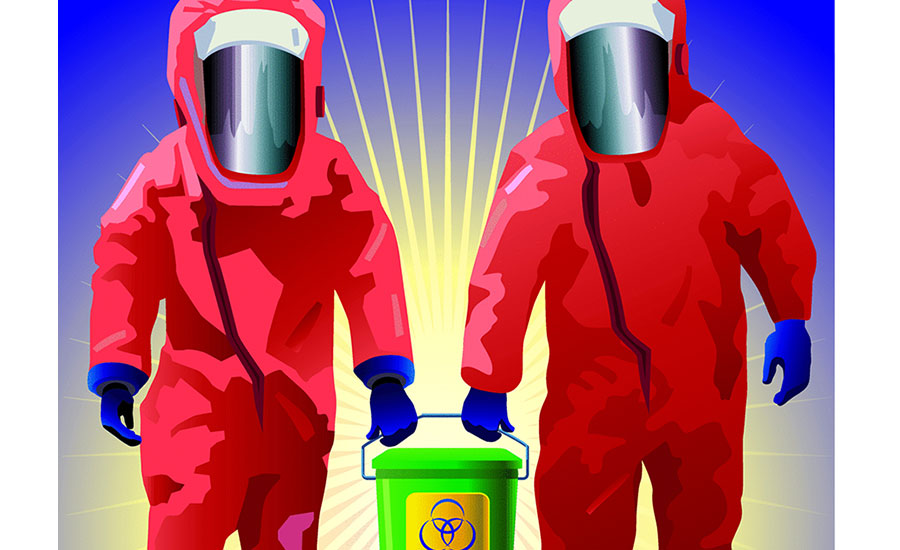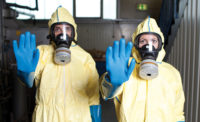A Monday morning session at the AIHce studies the risks of microbiology exposure.Workers in many different jobs may be exposed to various infectious biological agents either intentionally or accidentally.
Work-related infectious disease is referred to as disease that is caused or aggravated by occupational exposure to biological agents including bacteria, fungi, viruses and parasites (helminths, protozoa) through human, animal and/or environmental contact. The risk of infection depends on the pathogenicity of the biological agent of occupational aetiology, worker susceptibility, dose required to initiate infection, the mode of transmission, route of entry into the body and the presence of reservoirs or vectors.
Although biological hazards in the work environments have been around for more than a century, several events in the past decade, such as severe acute respiratory syndrome (SARS) and the 2009 influenza A (H1N1) pandemic, have renewed concerns of workers safety.
During the past two decades, occupationally acquired hepatitis B, human immunodeficiency virus (HIV) infection, multidrug-resistant tuberculosis (MDR-TB) and viral haemorrhagic fevers, among others, have killed or debilitated thousands of workers, however the exact numbers of fatal infections is not known, according to NIOSH
Work-related infection has been reported in the literature as the third-leading cause of occupational disease. Globally, an estimated 320 000 workers die annually from infectious diseases caused by bacterial, viral, animal and insect related biological hazards. The rate of infection varies widely by occupational setting and group.
For example, healthcare workers (HCWs) who are most often at the frontline of outbreaks of emerging agents and infectious patients are more at risk. The World Health Organization estimates the global burden of diseases as a result of work exposure among this group to be 40% for Hepatitis B and C infections and 2.5% for HIV infections, with 90% of occupational exposures being in the developing countries.
Challenges to identifying work-related infections
Although some work-related infectious diseases occur almost exclusively in certain occupations others are less connected to the work environment. The interactions between the worker, biological agent and the environment are complex. The link between disease and work is often obscured by the lack of distinctive characteristics of work-related infectious diseases leading to missed diagnosis and under-reporting.
Diseases may also be missed as workers may not always have access to occupational healthcare; occupational health doctors may not have access to proper diagnostic tools; monitoring programs may not cover the entire workforce, or may be restricted to certain diseases; and some industries may prioritize food safety over occupational health issues.
In addition, the relatively long incubation period (several weeks) between exposure and onset of disease means that establishing a relation between infection and work may be problematic. Rare occupational infections may easily be missed unless there is a high index of suspicion combined with an understanding of infectious diseases. This is further compounded in diseases which can occur in both the work and non-work environments.
Contemporary and emerging issues
The resurgence of certain diseases and the emergence of new or previously unrecognized microorganisms is gaining momentum. In most situations, mixed exposures occur in the workplace, leading to difficulty in identifying the causative agent.Also, different occupational groups may have similar exposure patterns.
Overuse or misuse of antibiotics has resulted in certain microorganisms such as Methicillin-resistant Staphylococcus aureus developing resistance to some anti-microbial agents. This jeopardizes the containment of infection and treatment of the disease (e.g. multi and extreme drug resistant TB) which not only increases the incidence and severity of illness but also the health costs. In addition, extreme weather patterns as a consequence of climate change may result in outbreaks of water-, mosquito- and rodent-borne diseases; posing a threat to emergency service and relief aid workers.
Work-related infectious diseases involve a broad spectrum of pathogenic agents across various occupational groups. It is known that workers die annually from occupationally acquired infections, however the mortality figures are mere estimates due to problems engendered by the lack of association between disease and workplace exposure.









